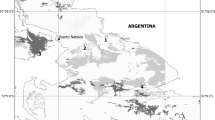Abstract
The tree-shrub savanna ‘Forêt Classée de Nazinon’ (Burkina Faso) is submitted to a management of grazing and rotational cutting of Detarium microcarpum. This species resprouts after cutting. In order to investigate whether this silvopastoral land use system is sustainable, aboveground herbaceous biomass was measured on subplots under uncut trees (‘uncut’), next to the stubs of cut trees (‘cut’) and on subplots not influenced by the (former) crowns of trees (‘open grassland’) in four lots. These lots were cut one, three, six and seven years before the study. Vegetation composition of the lots and the composition of the diet of cattle were also determined. Comparisons were made between treatments and lots. Herbaceous biomass was lower in the open grassland subplots than in uncut or cut subplots. We speculate that soil enrichment and more efficient precipitation input in (former) tree crown zones could have resulted in this pattern. Cutting and subsequent resprouting of trees did not lead to significant differences in herbaceous biomass between cut and uncut subplots. The most simple explanation for this is that the trees could extend their roots beyond the location of their neighbouring trees. Biomass and coverage of perennial grasses, mainly Andropogon ascinodis and Andropogon gayanus, did not change in lots cut one, three or six years before the study, but decreased dramatically in lots that were cut seven years before the study. When foraging, cattle spent more than 90% of their time feeding on these species. This indicates that, as a consequence of tree cutting, forage availability may be reduced to the point where local herdsmen are forced to take their cattle to another region.
Similar content being viewed by others
References
Archer S (1996) Assessing and interpreting grass-woody plant dynamics. In: Hodgson J and Illius AW (eds) The Ecology and Management of Grazing Systems, pp 101-134. CAB International, Oxon, UK
Belsky AJ (1994) Influence of trees on savanna productivity: test of shade nutrients, and tree-grass competition. Ecology 75: 922-932
Belsky AJ, Mwonga SM and Duxbury JM (1993) Effects of widely spaced trees and livestock grazing on understory environments in tropical savannas. Agroforestry Systems 24: 1-20
Belsky AJ, Amundson RG, Duxbury JM, Riha, SJ, Ali AR and Mwonga SM (1989) The effects of trees on their physical, chemical and biological environments in a semi-arid savanna in Kenya. Journal of Applied Ecology 26: 1005-1024
Ben-Shahar R (1992) The effects of bush clearance on African ungulates in a semi-arid nature reserve. Ecological Applications 2(1): 95-101
Breman H and Kessler JJ (1995) Woody Plants in Agro-Ecosystems of Semi-Arid Regions. Advanced series in agricultural sciences no. 23. Springer Verlag, Berlin, Germany, 340 pp
Brown JR and Archer S (1990) Water relations of a perennial grass and seedling vs. adult woody plants in a subtropical savanna, Texas. Oikos 57: 366-374
Coulibaly A (1993) Mission d'appui á l'aménagement pastoral de la forêt classée du Nazinon. Document FAO: FO: GCP/RAF/276/ITA. Ouagadougou, Burkina Faso, 33 pp
Diarra A and Selmi MT (1994) Aménagement des forêts naturelles pour la sauvegarde de l'environment et la production de bois. Document FAO: FO: BKF/89/011. Ouagadougou, Burkina Faso, 140 pp
Dublin HT (1995) Vegetation dynamics in the Serengeti-Mara ecosystem: the role of elephants, fire and other factors. In: Sinclair ARE and Arcese P (eds) Serengeti II, Dynamics, Management and Conservation of an Ecosystem, pp 71-90. University of Chicago Press, Chicago, USA
FAO (1988) FAO-Unesco soil map of the world: revised legend. World soil resources report 60. FAO, Rome, Italy, 109 pp
Kellman M (1979) Soil enrichment by neotropical savanna trees. Journal of Ecology 67: 565-577
Kelly RD and Walker BH (1976) The effects of different forms of land use on the ecology of a semi-arid region in south-eastern Rhodesia. Journal of Ecology 64: 553-576
Knoop WT and Walker BH (1985) Interactions of woody and herbaceous vegetation in a Southern African savanna. Journal of Ecology 73: 235-253
Le Houérou HN (1987) Indigenous shrubs and trees in the silvopastoral systems of Africa. In: Steppler HA and Nair PKR (eds) Agroforestry: A Decade of Development, pp 141-156. International Council for Research in Agroforestry, Nairobi, Kenya
Le Roux X, Bariac T and Mariotti A (1995) Spatial partitioning of the soil water resource between grass and shrub components in a West African humid savanna. Oecologia 104: 147-155
Ouedraogo A (1997) L'effet de la coupe de Detarium microcarpumGuill. & Perr. sur la régénération de la végétation dans la forêt classée de Nazinon. Msc thesis. University of Ouagadougou, Ouagadougou, Burkina Faso, 73 pp
Sala OE, Golluscio RA, Lauenroth WK and Soriano A (1989) Resource partitioning between shrubs and grasses in the Patagonian steppe. Oecologia 81: 501-505
Thies E (1995) Principaux ligneux (agro-) forestiers de la Guinée; Zone de transition Guinée-Bissau, Guinée, Côte d'Ivoire, Chana, Togo, Bénin, Nigeria, Cameroun. TZ Verlagsgesellschaft, Rossdorf, Germany
Walker BH, Ludwig D, Holling CS and Peterman RM (1981) Stability of semi-arid savanna grazing systems. Journal of Ecology 69: 473-498.
Werger MJA (1983) Tropical grasslands, savannas, woodlands: natural and manmade. In: Holzner W, Werger MJA and Ikusima I (eds) Man's Impact on Vegetation, pp 107-137. Dr. W. Junk publishers, The Hague, The Netherlands
Whittaker RH (1975) Communities and Ecosystems. 2nd edition, Macmillan, New York, USA, 385 pp
Author information
Authors and Affiliations
Corresponding author
Rights and permissions
About this article
Cite this article
Rietkerk*, M., Blijdorp, R. & Slingerland, M. Cutting and resprouting of Detarium microcarpum and herbaceous forage availability in a semiarid environment in Burkina Faso. Agroforestry Systems 41, 201–211 (1998). https://doi.org/10.1023/A:1006044630728
Issue Date:
DOI: https://doi.org/10.1023/A:1006044630728




